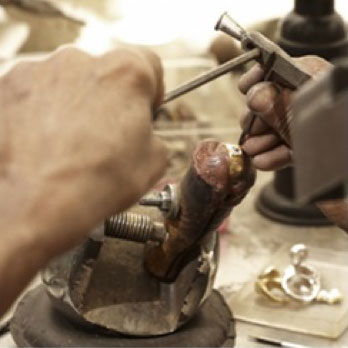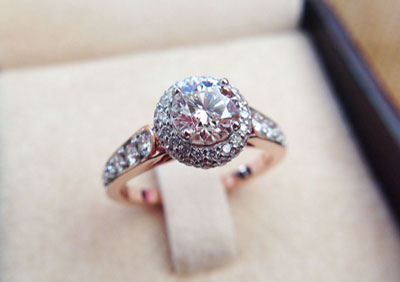How is an Engagement Ring Crafted?
Diamonds, emeralds and other gemstones, as well as precious metals such as gold and platinum, are mined from deep within the earth. Skilful craftsmen then transform these raw chemical and mineral elements into engagement rings that will be treasured for a lifetime.

Years ago precious metal and gem mines cruelly affected the lives of miners and the environment. Thanks to international efforts, including our own, most mining companies now work to reduce pollution, protect the environment and increase the miners’ quality of life. To maintain these important and radical changes in mining practices, we use only ethical diamonds, gold and platinum in our engagement rings.
Fashioning the Ring
Precious metals are refined soon after they leave the mines. Refining involves heating them to their melting point and skimming off the impurities or mixing them with acids. These powerful acids, which include nitric and hydrochloric acid, dissolve impurities in the metals and allow them to be washed away.

Once gold and platinum have been refined, they can be molded into rings using one of the following techniques:
-
Hand Fabrication – Long before machines were invented, jewellers heated precious metals and then gently hammered them into rings, chains and other jewellery. Today there are still jewellers who dedicate hours of time and attention to make engagement rings by hand.

- Die Striking – Gold and platinum destined for die striking are melted and cooled into thick sheets. These sheets then travel into a machine that uses special dies or patterns to cut out rings. Die striking lowers the cost of rings because it allows hundreds of rings to be made at once, but its downside is that the rings have to have a simple design.
- Casting – Casting is currently the most popular way to make an engagement ring. It involves designing the ring with sophisticated computer technology and then printing a 3D model that can be used to make a mold. The molten gold or platinum is then poured into the mold and allowed to harden into the desired shape.

Casting combines the best aspects of both hand fabrication and die striking in that it allows jewellers to use intricate designs and also cast multiple rings at one time.
Once a ring has been made and polished, diamonds, rubies and other gemstones can be added.
Setting the Gemstones

Gemstones are not attractive when they first leave the gem mines. Some of them are hidden within other types of rock and all of them are dirty and dull. There is no fire or brilliance.
These rough gemstones undergo three different phases of processing to become gems that are fit for engagement rings:
- Sorting – Diamonds, emeralds, rubies and other gemstones are sorted by size and quality after they leave the mine. Larger stones with few impurities go into the highest category and will be sold for the best prices, while stones that are smaller, have irregular shapes or a greater number of imperfections fall into lower categories.
- Cutting – Sorted gemstones then travel to gem cutting centers, which include Antwerp, Tel Aviv and New York. In these gem centers, lapidaries or gem cutters study each stone and consider its grain, color and defects to decide how best to cut it. They then use state-of-the-art machines to give each diamond, ruby or emerald the proper angles and facets to allow it to reflect the maximum amount of light.
- Polishing – Gemstones still have a few rough edges and minor surface blemishes after they go through the cutting process. These imperfections are removed by polishing the gems multiple times with different grits. These grits include coarse diamond dust for harder gemstones and cerium or aluminum oxide for softer stones.

The smooth, brilliant gemstones are now ready to be set into engagement rings. Every engagement ring is designed with a specific type of settings to hold stones. The most common setting is the prong setting, but other options include the channel and bezel settings.

All of these settings work by having prongs or strips of the ring’s metal that come up a little higher than the gemstone and can be bent over the gem to hold it in place. Larger gems are fairly easy to set into rings, but the tiny diamonds or other gems which are set into the sides of a ring or used to create a halo around a primary stone require steady hands and powerful magnifying glasses.
Once all the stones have been set in an engagement ring, the ring is double checked for any defects and is then given a thorough cleaning and one last polishing.

It is now ready to represent the beauty, resilience and value of true love and marriage.

